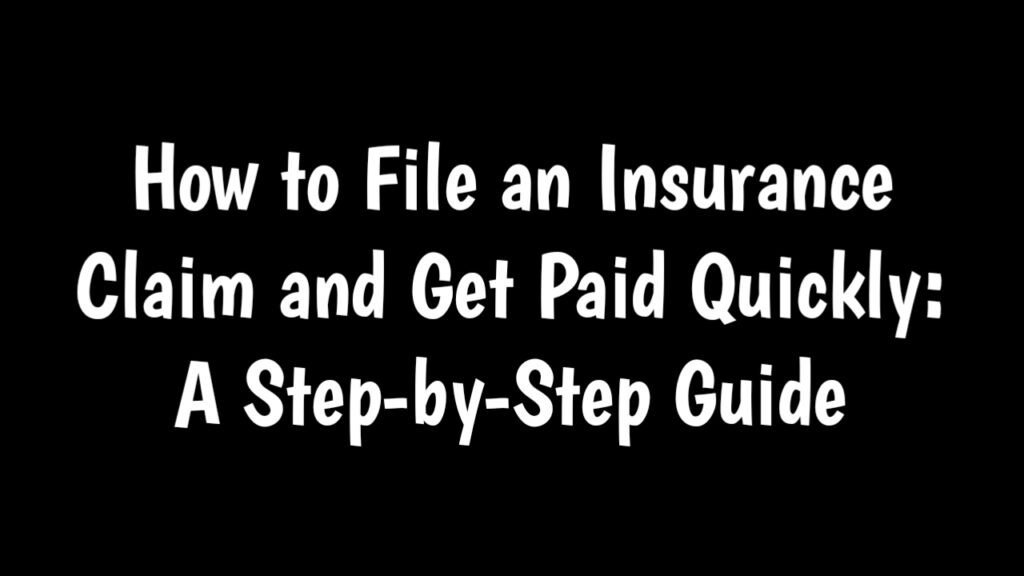
Insurance Claim : Filing an insurance claim can be a daunting task, but it doesn’t have to be. This step-by-step guide will walk you through the process of filing a claim and getting paid quickly, so you can get back to your life.
Introduction
When something unexpected happens, such as a car accident, home fire, or medical emergency, your first instinct may be to panic. However, it’s important to stay calm and take the necessary steps to file an insurance claim. By following the steps below, you can get your claim processed and paid as quickly as possible.
Table of Contents
Step 1: Contact your insurance company
The first step is to contact your insurance company and let them know that you need to file a claim. You can usually do this by calling their customer service number or visiting their website. When you contact your insurance company, be sure to have the following information ready:
- Your policy number
- Your name and contact information
- The date and time of the incident
- A brief description of what happened
Step 2: Gather documentation
Once you have filed your claim, your insurance company will ask you to gather documentation to support your claim. This documentation may include:
A police report, if applicable
Medical records, if applicable
Estimates for repairs or replacements
Receipts for any expenses you have incurred as a result of the incident
Step 3: Cooperate with the insurance adjuster
Your insurance company will assign an adjuster to your claim. The adjuster will be responsible for investigating your claim and determining how much your insurance company will pay. It is important to cooperate with the adjuster and provide them with all of the information they need.
Step 4: Review and accept the settlement offer
Once the adjuster has investigated your claim, they will make you a settlement offer. This offer will be based on the terms of your insurance policy and the extent of the damage. It is important to review the settlement offer carefully before accepting it. If you have any questions or concerns, be sure to discuss them with your adjuster.
Step 5: Receive your payment
Once you have accepted the settlement offer, your insurance company will issue you a payment. This payment may be made in the form of a check, direct deposit, or wire transfer. The time it takes to receive your payment will vary depending on your insurance company and the type of claim.
Tips for getting paid quickly
Here are a few tips for getting paid quickly on your insurance claim:
File your claim as soon as possible after the incident.
Gather all of the necessary documentation and provide it to your insurance company promptly.
Cooperate with the insurance adjuster and respond to their requests promptly.
Review the settlement offer carefully before accepting it.
Frequently asked questions
Q: How long does it take to get paid on an insurance claim?
A: The time it takes to get paid on an insurance claim will vary depending on the insurance company and the type of claim. However, most insurance companies will try to pay out claims within 30 days of receiving all of the necessary documentation.
Q: What if I don’t agree with the settlement offer?
A: If you don’t agree with the settlement offer, you can negotiate with the insurance adjuster. If you are still unable to reach an agreement, you may want to consider filing a complaint with your state’s insurance department.
Q: What if I need help filing my insurance claim?
A: If you need help filing your insurance claim, you can contact your insurance company or an insurance lawyer. An insurance lawyer can help you understand your rights and guide you through the claims process.
Conclusion
Filing an insurance claim can be a complex process, but it is important to follow the steps above to get your claim processed and paid as quickly as possible. By following these tips, you can minimize the stress and hassle of filing a claim and get back to your life.
Transition words:
- First, second, third: These words are used to sequence information.
- However, in addition, furthermore: These words are used to add information or contrast information.
- Therefore, as a result, consequently: These words are used to show cause and effect.
- For example, specifically: These words are used to provide examples or clarify information.
- Overall, in conclusion, finally: These words are used to summarize or conclude information.
Example:
First, contact your insurance company and let them know that you need to file
